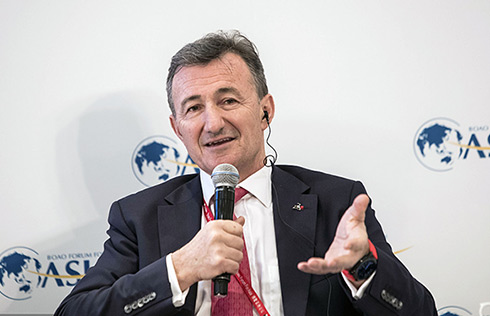Looking to find, feed new food consumers
In general, the country's total agricultural trading volume, including fish and forestry, reached $205.5 billion in 2012, up 9.3 percent from 2011. Nonetheless, the trade deficit in agriculture expanded to $56 billion, up 20 percent compared with 2011, according to a China Agricultural Trade Report in 2012 released by the United States Department of Agriculture Foreign Agricultural Service.
Faced with deteriorating trade conditions, such as the appreciation of the yuan, concerns over food safety and pollution in China as well as trade friction, farm exporters are trying to figure out a smooth path to avoid decreasing export volumes.
"Overall agricultural exports remain small and the added value of products is still low. For a long time, Chinese agricultural exporters have been pursuing short-term benefits, which has resulted in cutthroat competition," said Huang Guiheng, manager of Bric Global Agricultural Consultants.
"Although companies are realizing the problem and beginning to pay attention to research and innovation, it will take a long time to make advances in technology and risk management to form a solid basis to contend against international fluctuations and challenges," said Huang.
Huang said Chinese poultry producers have made progress in developing new products and finding multi-marketing channels in foreign trade. But they are still vulnerable because they are short of core technology.
Zhucheng Waimao is worrying about shrinking profit margins in exports in the next half of this year.
"With Japan's currency devaluation, Japanese buyers we signed orders with after March have asked for a reduction in price of 3 to 5 percent," said Wang. Wang's company receives orders in advance of just three to six months, so the business was not affected in the first five months of this year.
In fact, all of its products are dollar-denominated to fend off risks of floating exchange rates. But because its main market is in Japan, it has had to compromise this time.
Higher threshold
Further, bad impressions about Chinese food have led to a higher threshold for goods shipped from China.
"From 2008 to May this year, Japan has randomly checked 15,500 samples of our products. We have to pay 50,000 yen ($500) for each sample testing," he said.
In Japan, the sampling rate of Chinese products is fivefold compared with products from the US, according to Wang.
However, four products in every 10,000 Chinese food catalogs inspected by Japan's quality authorities failed Japanese standards last year, while the ratio for the US was six for every 10,000," Wang said, quoting information from Japan-based CGC, a chain of 220 companies and more than 3,000 stores.
The Japanese authorities will test for residues in processed foods that do not have specific provisional maximum levels for 758 chemicals used in agriculture, based on the concentration in the ingredients, according to the country's Food Sanitation Law.
Nonetheless, Japan, which accounts for 17.7 percent of China's total agricultural exports, was China's largest export market for the sector last year. Top export commodities included chicken, eels and frozen fish fillets, according to the US Department of Agriculture.
"As China's agriculture export destination is relatively concentrated to specific countries, such as Japan and South Korea, it is easy for a floating exchange rate to affect trade performance. Further, some of the countries are erecting trade barriers to protect their domestic production," said Wang Xiaoyue, a senior analyst with Beijing Orient Agribusiness Consultant Ltd, an agriculture and food business consulting company.
"Further transformation for these producers may still take place regarding developing diversified products, building brands and tapping into the domestic market," said Wang.
However, unlike Wang's poultry company, producers of agricultural commodities, such as garlic, are spending much more on research and development to add more value to raw materials.


























